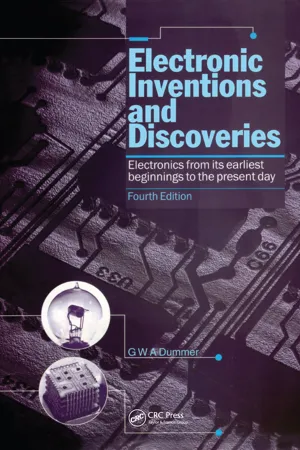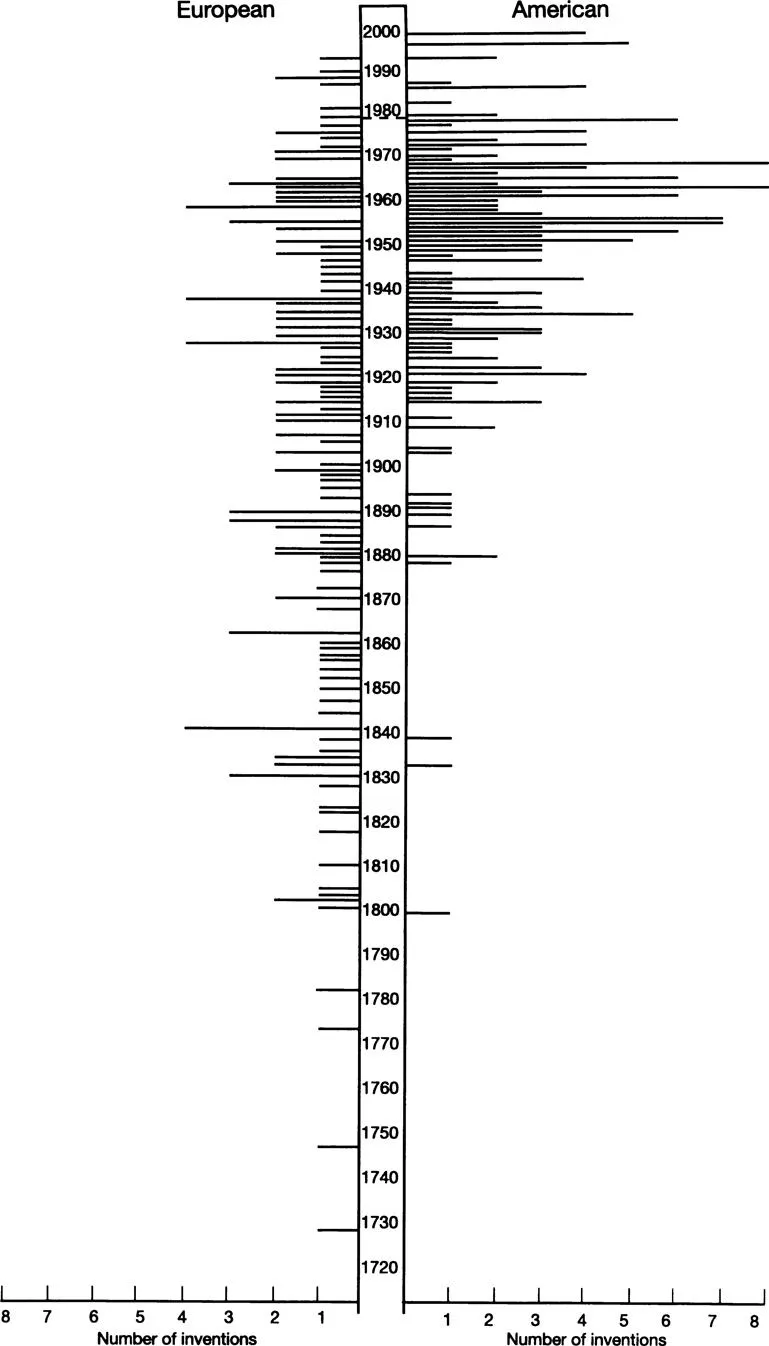![]()
Chapter 1
The Beginning of Electronics
For hundreds of years, two phenomena have been known to exist: static electricity and magnetism. These remained unexplained until the early 1700s when many practical experiments commenced on both electrostatics and magnetism. By the early 1800s, work by Galvani, Oersted and Faraday on galvanism, electromagnetism and electromagnetic induction opened up a new field of experimental work which ultimately paved the way to present-day electronics.
1.1 Electrostatics
Static electricity had been known for many centuries as some substances, when rubbed together, produced static charges which could generate sparks and, in other cases, could attract small pieces of paper and other materials. The Greeks knew that friction on amber material by fur gave rise to these attractive forces and the Greek word for amber was ‘electron’, although the word ‘electron’ was not really used until after 1897 when J J Thomson discovered the electron as we know it today.
Early in the 18th century, static electricity was being studied by many experimenters. In 1729, Stephen Gray distinguished between conductors and insulators. In 1730, Charles Fry discovered that electricity induced by rubbing could be of two kinds—positive and negative. The earliest method of measurement of static electricity was the gold-leaf electroscope, invented in 1787 by Bennet. This consisted of two strips of gold leaf which moved apart when a charge was applied to it. When a rod of ebonite was rubbed with a piece of fur, the ebonite would have a negative charge and the fur a positive charge. Glass rubbed with silk exhibited a similar phenomenon. Many ingenious methods of generating static electricity were developed. Faraday, in his early experiments, showed the distribution of static charges in hollow conductors. Many attempts were made to collect the charges continuously. The Kelvin replenisher was developed as a rotary device to build up the charges, but the most important device of this time was the Wimshurst machine, built later in 1882 (see figure 1.1). The problem of storing the energy was solved by the first capacitor—the Leyden jar—invented in 1745. Having produced static charges and calculated the potential voltages available (these could be quite high—Wimshurst machines were used for working x-ray tubes), measurement was now becoming important and electrometers of various types based on the earlier gold-leaf electroscope were developed, resulting in the first electrostatic voltmeters. Electrostatics could now be generated and stored for short periods, but could not be further used and attention was focused on the other phenomena—magnetism.
1.2 Magnetism
Magnetism has also been known for centuries. It was exhibited in lodestone, found in the vicinity of Magnetia in Asia Minor and termed ‘magnetite’. It has the property of attracting fragments of iron and when a bar of the material was suspended by its centre from a thread of silk, it aligned itself north and south. It was found that when stroked along a piece of steel, the steel also became magnetised and a knitting needle magnetised. In this way it became a magnet and aligned itself north and south when suspended, becoming the basis of the first compass.
About 1780, Galvani of Italy began experiments on animal electricity and when performing experiments on nervous excitability in frogs, he saw that violent muscle contractions could be observed if the lumbar nerves of the frogs were touched with metal instruments carrying electrical charges.
The problem of storage was still unsolved. The Wimshurst machine could generate but not store electricity and the Leyden Jar was limited in its storage capacity, but in 1800 Volta invented the electric battery. A ‘Volta’s pile’ consisted of copper and zinc discs separated by a moistened cloth electrolyte. The pile was later improved to consist of paper discs, tin one side, manganese dioxide on the other, stacked to produce 0.75 volt. This was soon followed by the first accumulator or rechargeable battery in 1803 by Ritter in Germany. The time was now ripe for the integration of electricity and magnetism and, in 1820, Oersted in Denmark, reported the discovery of electromagnetism and led him to develop the Galvanometer, allowing accurate measurements of currents and voltages to be made, and from this our present range of ammeters and voltmeters was developed.
In 1831, the most important discovery was made by Faraday of electromagnetic induction. He wound an iron ring with two coils, one connected to a battery, the other to a galvanometer. On connecting and reconnecting the battery, a reading was obtained on the galvanometer, although there was no direct connection. The first application of this discovery was the static transformer and dynamo. By causing a coil of wire (an armature) to rotate in a magnetic field so as to cut the lines of magnetic force, an ‘induced’ current was produced in the coil. The current changed in direction as the coil turned, through two right angles and an alternating current was produced. Direct current could be produced by using a commutator to reverse one half of the alternating current. The generation of electric power now became possible. An electric motor is similar in construction, but the current is passed through the armature, the force generated causing it to rotate. The early 1800s was a time of great progress in invention. Infra-red and ultra-violet radiation were discovered and, in 1808, Dalton put forward his atomic theory that all chemical elements were composed of minute particles of matter called atoms. Thermoelectricity, electrolysis and the photovoltaic effect were all discovered before 1840. Work on low-pressure discharge tubes, glow discharges, new types of battery and the early microphone took place in the next 20 years. It 1873 James Clerk Maxwell was the first to consider magnetic and electric fields together and formulated his equations from which he predicted electromagnetic radiation on purely theoretical grounds. He predicted wave propagation with a finite velocity, which he showed to be the velocity of light. Heinrich Hertz succeeded in producing electromagnetic waves experimentally in 1877 and confirming Maxwell’s predictions. He also added a loop of wire and increased the distance over which sparks could be transmitted, becoming the first radio communication.
It would be true to say that the majority of basic physical phenomena were discovered in the 75 years between 1800 and 1875, culminating in the practical applications of the telephone, phonograph, microphones and loudspeakers. Towards the end of the century, wireless telegraphy, magnetic recording and the cathode-ray oscillograph were all developed.
In 1911 Rutherford proposed the general model of the atom consisting of a nucleus of protons and neutrons, about which electrons rotated in orbits. In 1913, Bohr proposed that various stable orbits corresponded to various permissible energy levels
The early 1900s also saw the beginnings of many present-day electronic technologies. The three-electrode valve opened the way to radio broadcasting and Campbell-Swinton put forward his theory of television.
The advent of the 1914-18 war changed the pace of development and ‘electronics’ now covered a wider field of applications. New radio tubes and new circuits were developed for communications and after the war, radio astronomy, xerography, early radar, and computer techniques, were all ready to be further developed during the 1939-45 war. Under the pressure of this second war, radar and computer work led to a great increase in electronics research, and both governments and private industry set up large laboratories. From these came MASERS, LASERS, solar batteries and, in particular, in the 1950s, methods of perfecting ultra-pure materials, such as germanium and silicon. The stage was now set for the next major advance in electronics—the transistor, invented by the Bell Laboratories in 1948, enabling all electronics equipment to be miniaturised. The planar process invented in 1959 enabled many transistors to be manufactured simultaneously and the integrated circuit (known as the ‘chip’) was born.
![]()
Chapter 2
The Expansion of Electronics
The industrial revolution of the Victorian age created large industries—steel, ship building, textiles, railways, heavy machinery, etc. Today, these industries are in decline and the changeover to light industries based on later technologies, e.g. electronics, has presented re-employment and re-training problems. The exploitation of electronic inventions now creates wealth for those nations which take up the challenge, such as the USA, Europe, Japan and, more recently, other Far Eastern countries. New electronic industries are being built up employing large numbers of people, as instanced by the world’s semiconductor industry, now accounting for 4% of the world economy and already larger than any other manufacturing industry.
Whilst many of the basic electrical and electronic inventions were made in the last two centuries (see figure 2.1), the early 1960s saw the greatest expansion of electronics technology, and the integrated circuit, together with the computer, laid the foundation for the present-day world-wide expansion of electronic applications, of which typical examples are: world-wide communications, satellites, television, interactive and virtual TV, tape recorders, microwave ovens, calculators, microprocessors, data-processing systems, automotive electronics, educational electronics, industrial electronics, electronic cameras, medical electronics, robotics and many others.
Two examples of the present electronics age are the check-out counter till and aeroplane bookings. By using electronics techniques and merely passing a bar-coded object over a detection device, a detailed bill can be produced by an electronic computer in a matter of seconds. The number of seats in the 170 airlines throughout the world, flying to different destinations, must run into millions, yet any particular seat in any particular aeroplane from any destination to any other destination, can be booked from any airline booking office, due to electronics communications and computers.
Microprocessors and minicomputers have applications in accounting, banking, chemical process control, machine tool control, filing and record keeping (in hospitals, police and business firms), data analysis, instrumentation, automatic testing, automatic justifying or printing, and countless others.
In addition, the field of telecommunications and radar, both commercial and military, used in aircraft, tanks, ships, missiles, satellites, etc, is very large. There are also the component manufacturers who supply these applications, making integrated circuits, hybrids and many specialised devices.
The list of applications is ever-widening as new applications—such as the multimedia and Internet—are being exploited. Certainly, the field of electronics will continue to expand into both home and business life, with interactive and television presentations, combined with data-processing systems, becoming more and more widely adopted.
A brief summary of the growth of electronics over the years is given in figure 2.1, while figure 2.2 shows the possible effect of the ‘brain drain’ after the 1939/45 war.
![]()
Chapter 3
The Development of Components, Tubes, Transistors and Integrated Circuits
All electronic equipment is composed of components—resistors, capacitors, tubes, transistors, integrated circuits, etc. The development of such components is the story of electronics itself as, with each new invention in electronic techniques, components had to be developed and manufactured in quantity. The earliest components were those developed for the electrical industry—the Leyden Jar, the resistor, the transformer, the relay, the dry-battery, etc, all introduced between 1745 and 1900, originating mainly in Europe.
Radio telegraphy using spark transmitters towards the end of the 19th century was followed by continuous wave generators, such as the Alexanderson alternator, but when the thermionic tube was invented in 1906 continuous oscillation and amplification of radio frequencies became possible. Special tubes, transmitters and receivers were designed and built with the designer of the equipment constructing all the necessary component parts.
The 1914-18 war gave a marked impetus to the development of radio communications, and with the advent of the three-electrode tube in quantity, components such as resistors and capacitors began to assume the form roughly as we knew them up to the 1960s.
The BBC commenced programme broadcasting on 14 No...



